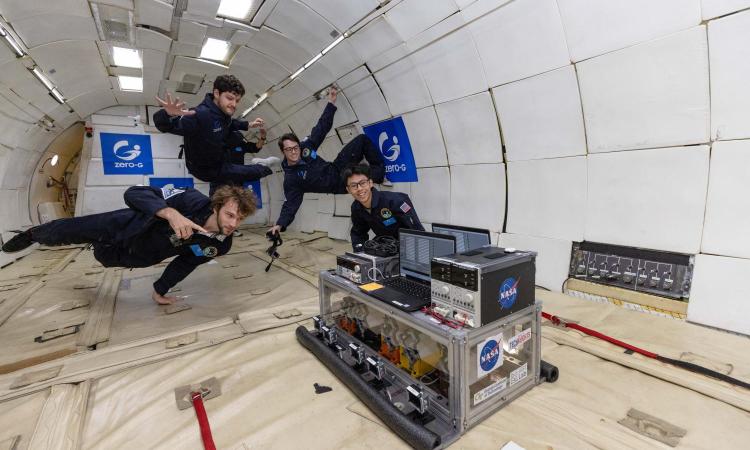Professor Álvaro Romero-Calvo and collaborators have created a simpler, more sustainable system to make oxygen in space — using magnets.
Ever since humans first ventured beyond Earth, the quest to efficiently and reliably produce oxygen in space has remained one of space exploration’s most persistent hurdles.
A team of scientists and researchers from the Georgia Institute of Technology, the Center of Applied Space Technology and Microgravity (ZARM) at the University of Bremen, and the University of Warwick has found a way to make oxygen production lighter, easier, and more sustainable — using magnetism.
The team described their system and demonstrated its effectiveness in a recent article in Nature Chemistry.
Current life support systems on board the International Space Station require astronauts to spin water in a centrifuge to separate oxygen and hydrogen gas bubbles from the liquid. Although effective, this method is heavy and mechanically complex, making it less than ideal for crewed deep space missions.
“One may think that extracting gas bubbles from liquids in space is as simple as opening a can of soda here on Earth. However, the lack of buoyancy makes the extraction process incredibly difficult, undermining the design and operation of oxygen production systems,” said Álvaro Romero-Calvo, an assistant professor at Georgia Tech. “In this paper, we demonstrate that two largely unexplored magnetic interactions – diamagnetism and magnetohydrodynamics – provide an exciting pathway to solve this problem and develop alternative oxygen production architectures.”
The Cost of Oxygen
Astronauts use electricity to split water into hydrogen and oxygen. On Earth, the gases bubble up, away from the electrodes. In the weightlessness of orbit, the bubbles stick to the electrodes and remain suspended in the liquid.
To extract the oxygen, spacecraft life support systems require complex, bulky, and power-hungry centrifuges connected to a water recirculation loop. The entire oxygen generation assembly consumes up to a third of the energy needed for the International Space Station’s life support architecture and requires frequent maintenance.
This makes the system impractical for deep space missions, where every pound of equipment is critical during launch, and any mechanical failure leads to a growing number of spare parts.
The Solution: Magnetism
In the new study, the team of researchers ditched the centrifuge for magnetic fields. Using commercial-grade magnets, they developed a passive phase separation system that pushes the bubbles away from the electrodes and collects them at designated spots.
To push the bubbles away, they first took advantage of how water naturally responds to magnets in microgravity, guiding gas bubbles toward collection points using a process called diamagnetism.
Then their system capitalized on the interaction between magnetic fields and electric currents generated by electrolysis, which creates a spinning motion.
This phenomenon, known as magnetohydrodynamics (MHD), is used to separate gas bubbles from water through centrifugal effects in the same way mechanical rotation does.
The approach was first developed in 2022 by Romero-Calvo as part of his Ph.D. thesis at the University of Colorado Boulder and then proved feasible under his Phase I grant from the NASA Innovative Advanced Concepts (NIAC) program.

Oxygen and hydrogen bubbles stream off of electrodes towards magnets (left and right sides) in a microgravity environment.
His Low-Gravity Science and Technology lab at Georgia Tech has recently been awarded a Phase II NIAC to develop a MHD oxygen production architecture for splitting water into oxygen and hydrogen for a Mars transit mission.
Prof. Katharina Brinkert’s group at ZARM carried out the electrochemical analysis and microgravity proof-of-concept tests of the technology at ZARM’s drop tower in Bremen, Germany. The ZARM drop tower is one of the tallest and best-known drop tower facilities in Europe, measuring 146 meters high, which results in 9.3 seconds of microgravity experiment time.
(text and background only visible when logged in)
After four years of hard work, showing that magnetic forces can control electrochemical bubbly flows in microgravity is an exciting step towards more efficient and reliable spacecraft life support systems. Working with our collaborators and stakeholders has been incredibly fulfilling, and we can’t wait for the next steps.
Álvaro Romero-Calvo
(text and background only visible when logged in)
Together, the Georgia Tech and ZARM team discovered that magnetic forces enhance the efficiency of electrochemical cells by up to 240 percent thanks to the enhanced gas bubble detachment, boosting the overall efficiency of the electrolysis process.
“After four years of hard work, showing that magnetic forces can control electrochemical bubbly flows in microgravity is an exciting step towards more efficient and reliable spacecraft life support systems. Working with our collaborators and stakeholders has been incredibly fulfilling, and we can’t wait for the next steps," said Romero-Calvo.
The team is set to work under NIAC and ESA SciSpacE programs to assess the implementation, scalability, and long-term efficiency of several magnetic water-splitting architectures using the microgravity drop tower and suborbital rocket experiments. All so that, one day astronauts can breathe freely on their journey to Mars — and beyond.
(text and background only visible when logged in)
About the Research:
This research was supported by the German Aerospace Center (DLR), the European Space Agency (ESA) and the National Aeronautics and Space Administration (NASA). Any opinions, findings, and conclusions or recommendations expressed in this material are those of the authors and do not necessarily reflect the views of any funding agency.
(text and background only visible when logged in)
Related News:

NASA Selects Professor Álvaro Romero-Calvo to Study New Magnetohydrodynamic Technology
AE Assistant Professor Álvaro Romero-Calvo will serve as the principal investigator on a NASA Innovative Advanced Concepts (NIAC) project to research an alternative system through a new, more efficient water-splitting architecture that combines multiple functionalities with reduced subsystems.
(text and background only visible when logged in)

Georgia Tech CubeSat Propellant Innovation Set to Transform Space Missions
Professor Álvaro Romero-Calvo and a team of Georgia Tech engineers have been selected by NASA for a TechFlights award — an effort managed by NASA’s Flight Opportunities program, which demonstrates technologies through suborbital and hosted orbital testing with industry flight providers.
(text and background only visible when logged in)
